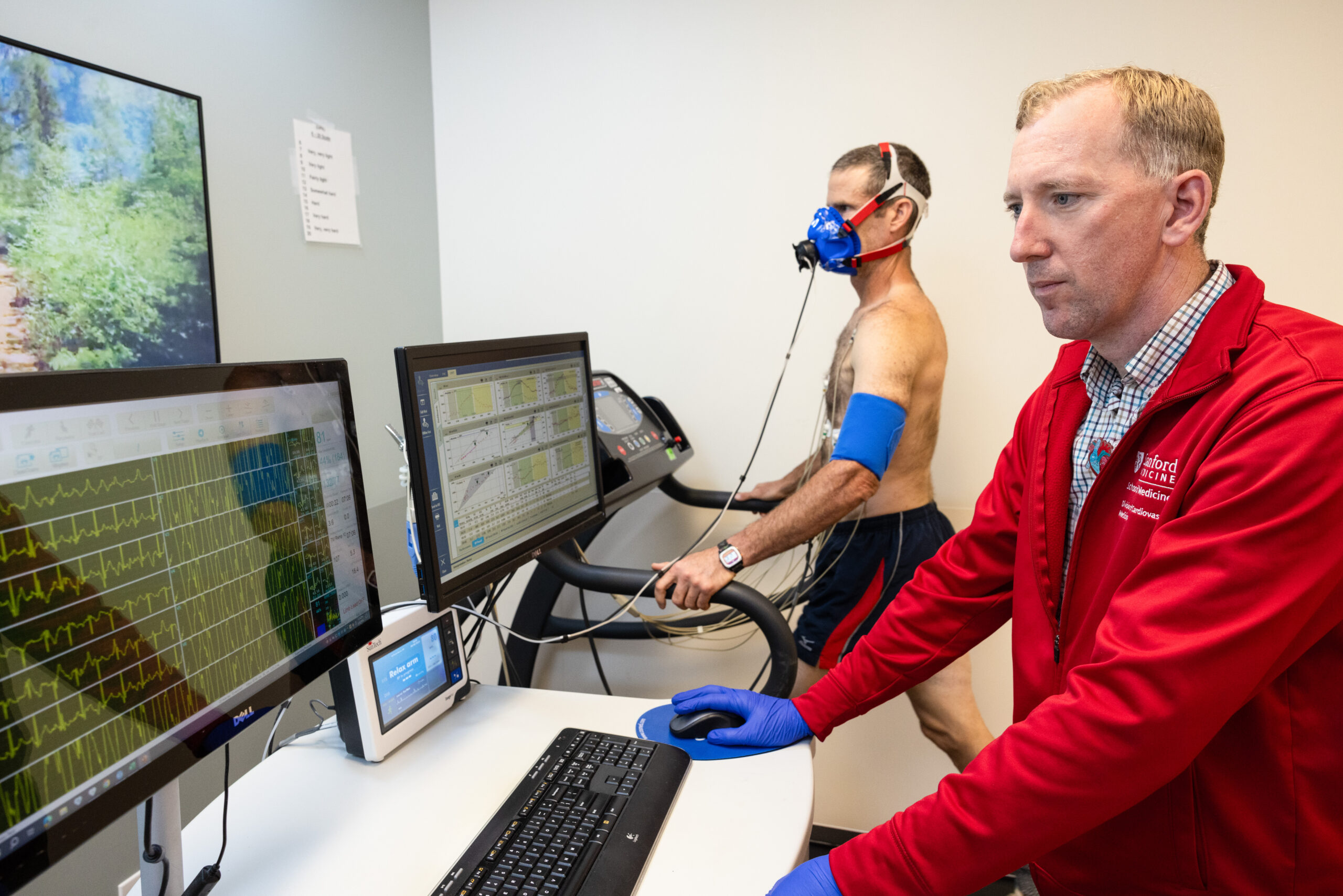
Redefining Cardiovascular Care for Athletes
#Interventions
Jason Tso, MD, sports cardiologist and medical director of the Sports Cardiology Program at Stanford, is himself a dedicated cyclist and runner.
It’s a scenario that Jason Tso, MD, assistant professor of cardiovascular medicine, has heard too many times: An avid runner detects that something is possibly awry with their cardiovascular system. Their sports watch alerts them to an arrhythmia, or they find their heart rate spiking at paces that once felt easy. The runner’s primary care provider refers them to a general cardiologist, who tells them that if it only happens when they run, they should stop running.
His frustration is palpable when he hears the latest instance of this story. “See, I hate that. That’s what people come to see me for. They hear that, and that’s just not acceptable.”
The Nuanced Athlete’s Heart
Though common wisdom states that exercise is the best medicine, runners and other athletes are not immune to cardiovascular issues. Some young athletes have inherited cardiovascular diseases that pose risks regardless of fitness.
As athletes age, a percentage eventually face the standard ailments common in older adults, including coronary artery disease. And still other athletes discover through testing that they have an enlarged heart ventricle or aorta. It could be a heart condition. Or it could be the hypertrophy that any muscle experiences when it is regularly exercised.
“Taken out of context, a very healthy 25-year-old runner’s heart can look like someone with early heart failure,” Tso says. As the medical director of the Sports Cardiology Program at Stanford and Stanford’s first dedicated sports cardiologist, he specializes in that context.
In the case where an otherwise healthy athlete notices that something feels different, practitioners who do not usually care for athletes may dismiss their concerns. The patient is so fit, they must be well. “A general physician will have a lot of trouble distinguishing an unhealthy athlete from a healthy nonathlete,” says Jeff Christle, PhD, a clinical exercise physiologist and Tso’s colleague in the Stanford Sports Cardiology clinic.
That’s when the persistent athlete ends up seeing someone like Jason Tso.
“We’re just seeing so many very active people now. It’s not just the running and the cycling. People like going to the gym. People like working out, and they find enjoyment in just being fit. Whether it’s weightlifting, mountain biking, whatever… it’s important that we support people through that.”
– Jason Tso, MD
An Athlete Treating Athletes
Too often, general cardiologists give athletes with cardiovascular concerns a rote mandate: Stop exercising, or stop exercising intensely. But this type of advice is anathema to athletes. For some, sports may be their career. For others, pushing their physical limits is central to their identity and quality of life. Many athletes, if simply told to stop, will not.
Tso is himself an athlete. Between university and medical school, he spent two years as a competitive cyclist – an amateur, but the kind of amateur whose name appears near the very top of race results and Strava leaderboards for fastest times on a given map segment. He runs as well, with a 2023 California International Marathon (CIM) time of 2:52, a time fast enough to qualify for the prestigious Boston Marathon.
In the clinic, Tso sees people ranging from Stanford student-athletes who undergo routine screening to Bay Area professional and recreational athletes with cardiovascular concerns. Patients undergo cardiopulmonary exercise testing (CPET), usually on a treadmill or stationary bike, to evaluate their cardiovascular system. The test measures a person’s VO2 max, a common aerobic fitness metric that measures how much oxygen the body can use during exercise. It can also detect exercise-induced asthma and re-create exercise-induced symptoms, such as chest pain, in a controlled environment. Some patients receive additional testing, such as electrocardiograms to monitor their heartbeat or pre- and post-CPET ultrasounds to image the structure of the heart.
Defining Risk Thresholds
If the testing does reveal a heart condition, Tso assesses the condition’s severity level and works with the patient to set risk-based exercise thresholds.
Quantifying the danger is helpful. Most athletes want to keep exercising, he says, “but they don’t really want to push so hard they’re endangering themselves.” He may counsel an older runner with mild heart failure, for example, on safe intensity zones based on their own test results. The patient gets to continue doing what they love, and what may ultimately help their overall health, with a better understanding of where the risk lies.

Jeffrey Christle, PhD, with a test subject in the Stanford cardiopulmonary exercise testing lab
Practicing at the Frontiers of Sports Technology
Patients’ ability to follow guidelines and adhere to risk thresholds is aided in part by rapidly evolving technology.
Athletes from professionals to amateurs have access to sophisticated sports watches, heart rate monitors, and other fitness wearables that track an array of cardiovascular data, such as resting heart rate, heart rate variability, and approximate VO2 max.
“Athletes are coming in more now with their own data that might indicate something’s wrong,” Tso says.
It’s not perfect, he cautions. Along with quality data, “right now, we see a lot of nonsense.” Nonsense such as a purported abnormal heart rate that actually is a sports watch confounding a runner’s cadence with their heartbeat, which can result in an alarmingly high but ultimately incorrect reading. But there are also more reliable wearables on the market, such as chest strap heart rate monitors. As technology has improved, Tso considers it increasingly important.
Supporting the Full Spectrum of Active Individuals
The technological advancement in fitness wearables is driven in part by swelling consumer demand.
“People see sports cardiology as seeing super-high-level athletes and helping to prevent illness and disease, as well as trying to get them to perform at the highest level they can,” says Christle. Tso, Christle, and their Sports Cardiology clinic colleagues treat professional and Division I athletes for just those purposes.
But as institutions like the American College of Sports Medicine promote “exercise as medicine,” Christle says, and people follow that advice, it creates a huge demand for sports cardiology in the broader population.
“We’re just seeing so many very active people now,” Tso says. “It’s not just the running and the cycling. People like going to the gym. People like working out, and they find enjoyment in just being fit. Whether it’s weightlifting, mountain biking, whatever.”
As this cultural shift unfolds, he says, “it’s important that we support people through that.”
